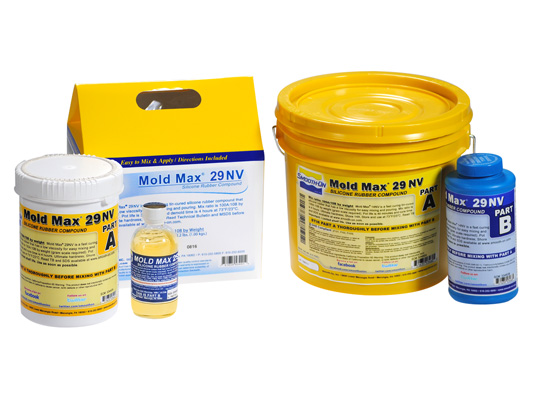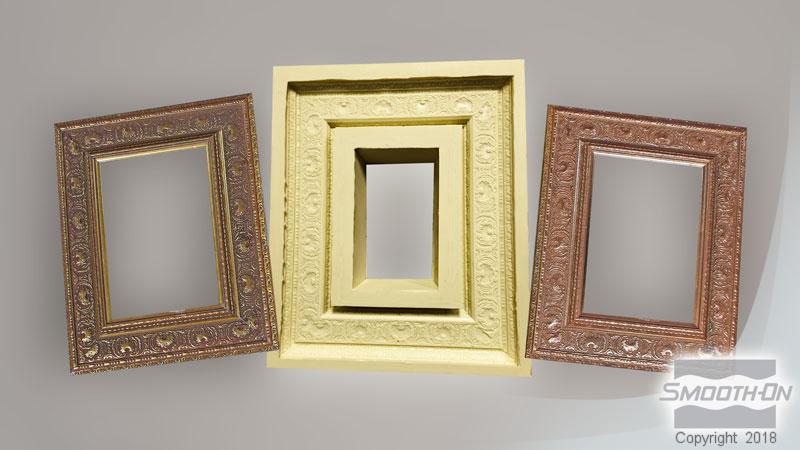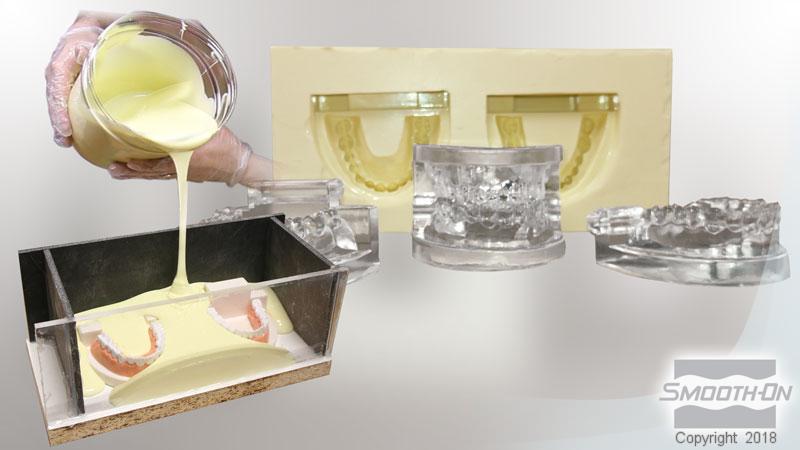Mold Max™ 29NV

重要 ; 必须使用克量级秤来称量A组份和B组份,以成功使用MoldMax™29NV
说明
Safety – Use in a properly ventilated area (“room size” ventilation). Wear safety glasses, long sleeves and rubber gloves to minimize contamination risk. Wear vinyl gloves only. Latex gloves will inhibit the cure of the rubber.
Store and use material at room temperature (73°F/23°C). Storing material at warmer temperatures will also reduce the usable shelf life of unused material. These products have a limited shelf life and should be used as soon as possible.
Applying a Sealer / Release Agent - Mold Max™ rubber may be inhibited by sulfur based clays resulting in tackiness at the pattern interface or a total lack of cure throughout the mold. If compatibility between the rubber and the surface is a concern, a small-scale test is recommended. Apply a small amount of rubber onto a non-critical area of the pattern. Inhibition has occurred if the rubber is gummy or uncured after the recommended cure time has passed. To prevent inhibition, a “barrier coat” of clear acrylic lacquer sprayed directly onto the pattern is usually effective. Allow to thoroughly dry.
Although not usually necessary, a release agent will make demolding easier when casting into or over most surfaces.
Ease Release™ 200 is a proven release agent for making molds with silicone rubber and for releasing new silicone from cured silicone. Mann Ease Release™ products are available from Smooth-On or your Smooth-On distributor.
Because no two applications are quite the same, a small test application to determine suitability for your project is recommended if performance of this material is in question.
MEASURING & MIXING...
Materials should be stored at about 73°F / 23°C. These products have a limited shelf life and should be used as soon as possible. Wear safety glasses, long sleeves and rubber gloves to minimize contamination risk. Before you begin, pre-mix Part A (base) thoroughly to re-disperse fillers that may have settled. Using a gram scale, dispense required amounts of parts A and B into a mixing container and mix for 3 minutes. Scrape the sides and bottom of the container several times.
POURING ...
For best results, pour your mixture in a single spot at the lowest point of the containment field. Let the rubber seek its level up and over the model. A uniform flow will help minimize entrapped air. The liquid rubber should level off at least 1/2” (1.3 cm) over the highest point of the model surface.
CURING & PERFORMANCE ...
Curing / Post Curing - Allow the mold to cure fully (at least 6 hours) at room temperature (73°F/23°C) before demolding. Post curing the mold an additional 4 hours at 150°F (65°C) will eliminate any residual moisture and alcohol that is a by-product of the condensation reaction that can inhibit the cure of some resins and rubbers. Allow mold to cool to room temperature before using. Do not cure rubber where temperature is less than 65°F/18°C.
Accelerating Mold Max™ 29NV - Accel-T™ tin cure silicone rubber accelerator will accelerate the cure time of Mold Max™ 29NV. Note: working time is reduced in proportion to the amount of Accel-T™ added.
Thinning Mold Max™ 29NV - Silicone Thinner™ is a non-reactive silicone fluid that will lower the mixed viscosity of tin cure (condensation) or platinum cure (addition) silicone rubber products. Silicone Thinner™ offers the following advantages: [1] A lower mixed viscosity (A+B) means that the rubber will de-air faster when vacuuming; [2] Mixed rubber (A+B) will flow better over intricate model detail; [3] Silicone Thinner™ will lower the ultimate shore hardness (durometer) of cured silicone rubber; [4] Pot life (working time) is increased in proportion to the amount of Silicone Thinner™ used.
A disadvantage is that ultimate tear and tensile are reduced in proportion to the amount of Silicone Thinner™ added, however knotty tear properties of the Mold Max™ Series rubbers are unaffected. It is not recommended to exceed 10% by weight of total system (A+B). See the Silicone Thinner™ technical bulletin (available from Smooth-On or your Smooth-On distributor) for full details.
Making Brush-On Rubber Molds - Due to low viscosity, Mold Max™ 29NV is not recommended for making brush-on rubber molds. If you want to make a brush-on rubber mold, Mold Max™ Stroke™ was developed especially for this purpose.
Mold Performance & Storage - The physical life of the mold depends on how you use it (materials cast, frequency, etc.). Casting abrasive materials such as concrete can quickly erode mold detail, while casting non-abrasive materials (wax) will not affect mold detail. Before storing, the mold should be cleaned with a soap solution and wiped fully dry. Two part (or more) molds should be assembled. Molds should be stored on a level surface in a cool, dry environment.

